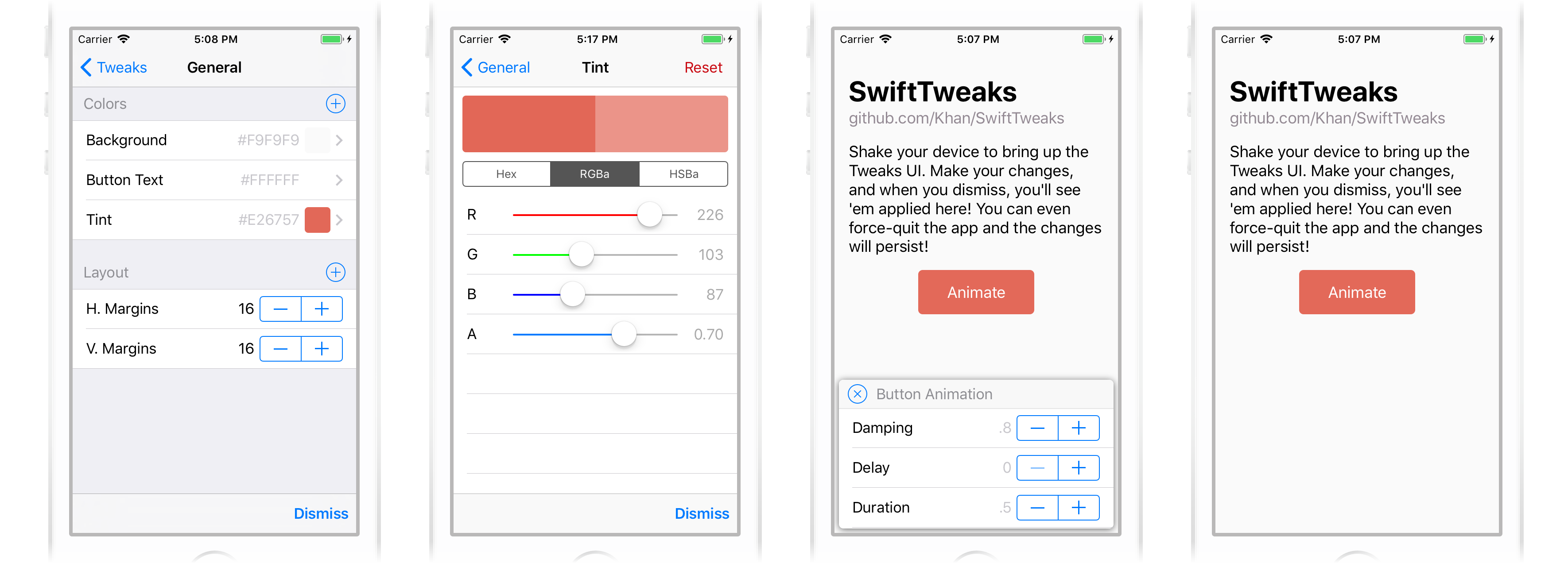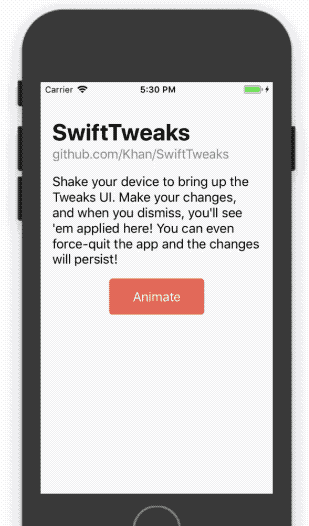SwiftTweaks alternatives and similar libraries
Based on the "Utility" category.
Alternatively, view SwiftTweaks alternatives based on common mentions on social networks and blogs.
-
SwifterSwift
A handy collection of more than 500 native Swift extensions to boost your productivity. -
SwiftGen-Storyboard
The Swift code generator for your assets, storyboards, Localizable.strings, … — Get rid of all String-based APIs! -
SwiftGen
The Swift code generator for your assets, storyboards, Localizable.strings, … — Get rid of all String-based APIs! -
SwiftLinkPreview
It makes a preview from an URL, grabbing all the information such as title, relevant texts and images. -
Playbook
📘A library for isolated developing UI components and automatically taking snapshots of them. -
BetterSafariView
A better way to present a SFSafariViewController or start a ASWebAuthenticationSession in SwiftUI. -
Pythonic.swift
DISCONTINUED. Pythonic tool-belt for Swift – a Swift implementation of selected parts of Python standard library. -
SwiftPlantUML
A command-line tool and Swift Package for generating class diagrams powered by PlantUML
InfluxDB - Power Real-Time Data Analytics at Scale

* Code Quality Rankings and insights are calculated and provided by Lumnify.
They vary from L1 to L5 with "L5" being the highest.
Do you think we are missing an alternative of SwiftTweaks or a related project?
README
SwiftTweaks
Adjust your iOS app on the fly without waiting to re-compile!
![]()
Your users won’t see your animation study, Sketch comps, or prototypes. What they will see is the finished product - so it’s really important to make sure that your app feels right on a real device!
Animations that look great on your laptop often feel too slow when in-hand. Layouts that looks perfect on a 27-inch display might be too cramped on a 4-inch device. Light gray text may look subtle in Sketch, but it’s downright illegible when you’re outside on a sunny day.
These animation timings, font sizes, and color choices are all examples of “magic numbers” - the constants that give your app its usability and identity. The goal of SwiftTweaks: allow you to fine-tune these magic numbers in the debug builds of your Swift project, without having to wait for Xcode to rebuild the app.

Overview
Use a Tweak in place of a boolean, number, or color in your code. You can adjust that Tweak without having to recompile, which means you can play with animation timings, colors, and layouts without needing Xcode!
Currently, you can tweak the following types:
BoolIntCGFloatDoubleUIColorTweakCallbacksStringStringOption
A Tweak looks like this:
public static let colorTint = Tweak("General", "Colors", "Tint", UIColor.blueColor())
There are also helpful TweakGroupTemplate types, so you can quickly declare commonly-used-together combos. They all have sensible defaults, but of course, you can set your own!
// Controls delay and duration for UIView.animate
// Use it with UIView.animate(basicTweakTemplate:...)
public static let basicAnimation = BasicAnimationTweakTemplate("Animation", "Basic Animation")
// Controls delay, duration, damping, and initial spring velocity for UIView.animate
// Use it with UIView.animate(springTweakTemplate:...)
public static let springAnimation = SpringAnimationTweakTemplate("Animation", "Spring Animation")
// Controls shadow color, radius, offset, and opacity for CALayer
// Use it with CALayer.apply(shadowTweakTemplate:...)
public static let shadowTweak = ShadowTweakTemplate("Shadows", "Button Shadow")
// Controls top/right/bottom/left for UIEdgeInsets
// Use it with UIEdgeInsets.init(edgeInsetsTweakTemplate)
public static let edgeInsets = EdgeInsetsTweakTemplate("Layout", "Screen Edge Insets")
Of course, you can create your own TweakGroupTemplate type if you'd like - they're handy whenever you have a cluster of tweaks that need to be used together to get a desired effect. They can be built out of any combination of Tweaks.

Callbacks
SwiftTweaks now supports callbacks. If you need to execute more complicated operations or operations that do not depend on data from certain tweak value.
You can use TweakCallbacks as a type in your TweakStore to create a Tweak that executed your custom callbacks.
public static let action = Tweak<TweakCallbacks>("Actions", "Action", "Perform some action")
Later in the code you can add callbacks to that tweak, which are executed when a button in Tweaks window is pressed.
let idenfitier = ExampleTweaks.action.addCallback {
/// Some complicated action happens here
print("We're all done!")
}
If you want to, you can also always remove callback using unique idenfitier that addCallback method provides.
ExampleTweaks.action.removeCallback(with: idenfitier)
Wait, what about Facebook Tweaks?
Good question! I’m glad you asked. The whole reason SwiftTweaks exists is because we love the stuffing out of FBTweaks. We’re long-time fans of FBTweaks in our Objective-C projects: Replace the magic numbers with an FBTweak macro, and you’re all set! You can leave an FBTweak macro in your production code, because it’s replaced at compile-time with the tweak’s default value.
But Swift doesn’t support this macro-wizardry, so FBTweaks is burdensome to use in Swift code. Our app is nearly all Swift, so we wanted to see if we could make something that was a little easier!
Steps to Tweaking
There are three steps to add SwiftTweaks to your project:
- Create a
TweakLibraryType, which contains a set ofTweaks and aTweakStoreto persist them. - Reference that
TweakLibraryTypein your code to use aTweak. - In your AppDelegate, make the
TweakWindowthe window of your app (there are other options, but this is the most straightforward! More on that later.)
Now build-and-run, then shake your phone to bring up the Tweaks UI! Adjust tweaks, and when you’re satisfied with what you’ve got, share your tweaks with others from within the Tweaks UI.
Step One: Make your TweakLibrary
A tweak library is responsible for listing out a bunch of public static tweaks, and building a TweakStore. A tweak library looks like this:
public struct ExampleTweaks: TweakLibraryType {
public static let colorTint = Tweak("General", "Colors", "Tint", UIColor.blue)
public static let marginHorizontal = Tweak<CGFloat>("General", "Layout", "H. Margins", defaultValue: 15, min: 0)
public static let marginVertical = Tweak<CGFloat>("General", "Layout", "V. Margins", defaultValue: 10, min: 0)
public static let featureFlagMainScreenHelperText = Tweak("Feature Flags", "Main Screen", "Show Body Text", true)
public static let buttonAnimation = SpringAnimationTweakTemplate("Animation", "Button Animation")
public static let defaultStore: TweakStore = {
let allTweaks: [TweakClusterType] = [colorTint, marginHorizontal, marginVertical, featureFlagMainScreenHelperText, buttonAnimation]
let tweaksEnabled = TweakDebug.isActive
return TweakStore(
tweaks: allTweaks,
enabled: tweaksEnabled
)
}()
}
Let’s break down what happened here:
- We have four tweaks in
ExampleTweaks: a tint color, twoCGFloats for layout, and aBoolthat toggles an in-development feature. - The compiler can get confused between
Int,CGFloat, andDouble- so you might find it necessary to tell theTweak<T>what type itsTis - as we do here with our margin tweaks. - We create a
defaultStoreby creating aTweakStore, which needs to know whether tweaks areenabled, and a list of alltweaks. - The
enabledflag onTweakStoreexists so thatSwiftTweaksisn’t accessible by your users in production. You can set it however you like; we enjoy using theDEBUGflag from our project’s Build Settings.
Step Two: Using Your TweakLibrary
To use a tweak, you replace a number or UIColors in your code with a Tweak reference, like this:
Here’s our original code:
button.tintColor = UIColor.green
assign returns the current value of the tweak:
button.tintColor = ExampleTweaks.assign(ExampleTweaks.colorTint)
bind calls its closure immediately, and again each time the tweak changes:
ExampleTweaks.bind(ExampleTweaks.colorTint) { button.tintColor = $0 }
bindMultiple calls its closure immediately, and again each time any of its tweaks change:
// A "multipleBind" is called initially, and each time _any_ of the included tweaks change:
let tweaksToWatch: [TweakType] = [ExampleTweaks.marginHorizontal, ExampleTweaks.marginVertical]
ExampleTweaks.bindMultiple(tweaksToWatch) {
let horizontal = ExampleTweaks.assign(ExampleTweaks.marginHorizontal)
let vertical = ExampleTweaks.assign(ExampleTweaks.marginVertical)
scrollView.contentInset = UIEdgeInsets(top: vertical, right: horizontal, bottom: vertical, left: horizontal)
}
For more examples, check out the example project’s ViewController.swift file.
Step Three: Set TweakWindow as your Root View Controller
By default, SwiftTweaks uses a shake gesture to bring up the UI, but you can also use a custom gesture!
Installation
Carthage
To add SwiftTweaks to your application, add it to your Cartfile:
github "Khan/SwiftTweaks"
In addition, add -DDEBUG to Other Swift Flags in your project's Build Settings for your Debug configuration.
CocoaPods
pod 'SwiftTweaks'
# Enable DEBUG flag in Swift for SwiftTweaks
post_install do |installer|
installer.pods_project.targets.each do |target|
if target.name == 'SwiftTweaks'
target.build_configurations.each do |config|
if config.name == 'Debug'
config.build_settings['OTHER_SWIFT_FLAGS'] = '-DDEBUG'
end
end
end
end
end
FAQ
Do I have to set TweakWindow as the root of my app?
Nope! Wherever/however you prefer, just create a TweaksViewController like so:
let tweaksVC = TweaksViewController(tweakStore: ExampleTweaks.defaultStore)
Can I have multiple TweakLibraryTypes in my app?
Sure! You’d initialize their defaultStores with a unique storeName identifier, like so:
public struct FirstTweaksLibrary: TweakLibraryType {
// ...
public static let defaultStore: TweakStore = {
let allTweaks: [TweakClusterType] = //...
return TweakStore(
tweaks: allTweaks,
storeName: "FirstTweaksLibrary", // Here's the identifier
enabled: tweaksEnabled
)
}()
}
Why can’t any type be used for a Tweak?
While Tweak<T> is generic, we have to restrict T to be TweakableType so that we can guarantee that each kind of T can be represented in our editing interface and persisted on disk. More types would be awesome, though! It’d be neat to support dictionaries, closures, and other things.
If you’d like to extend TweakableType, you’ll need to extend some internal components, like TweakViewDataType, TweakDefaultData, TweakViewData, and TweakPersistency. Feel free to open a pull request if you’d like to add a new type!
How do I create a new TweakGroupTemplate?
Maybe you’re using a different animation framework, or want a template for CGRect or something like that - great! As long as the tweakable “components” of your template conform to TweakableType then you’re all set. Create a new TweakGroupTemplateType, and take a look at the existing templates for implementation suggestions. (You’ll probably want to use SignedNumberTweakDefaultParameters too - they’re very helpful!)
If you think your TweakGroupTemplateType would help out others, please make a pull request!






